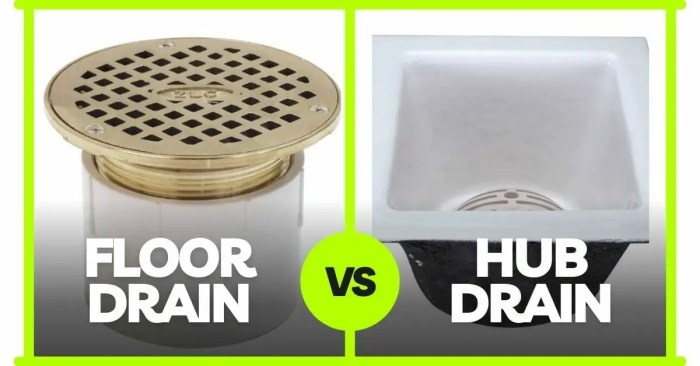Hub drain vs floor drain – In the plumbing world, hub drains and floor drains play crucial roles in drainage systems. Understanding the distinctions between these two types of drains is essential for informed decision-making during installation and maintenance. Let’s dive into the captivating world of hub drains versus floor drains, where functionality and design converge.
Hub drains, often found in sinks and bathtubs, are characterized by their central hub that connects to the drainpipe. Floor drains, on the other hand, are installed directly into the floor and are commonly used in areas prone to water accumulation, such as bathrooms and laundry rooms.
Overview of Hub Drain and Floor Drain
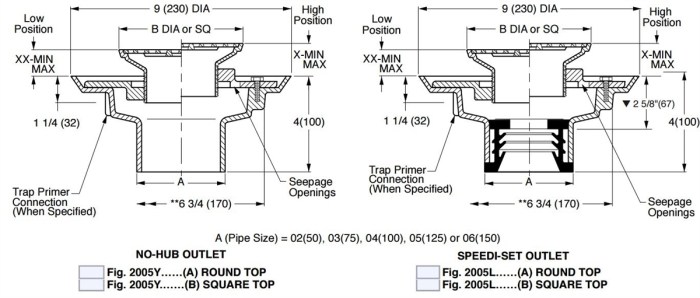
Hub drains and floor drains are essential components of plumbing systems, serving different purposes and locations within a building.
When considering plumbing fixtures, it’s important to understand the difference between a hub drain and a floor drain. Hub drains are typically used for sinks and bathtubs, while floor drains are designed to collect water from the floor. For a deeper understanding of historical terms, check out apush period 4 key terms . Returning to our plumbing topic, hub drains connect to the drainpipe via a hub, while floor drains have a strainer to prevent debris from entering the drainpipe.
A hub drain is a type of drain that connects to a pipe or fixture using a threaded or compression joint. It typically has a flange or hub that fits around the pipe, creating a watertight seal. Hub drains are commonly used in sinks, bathtubs, and showers.
On the other hand, a floor drain is a drain that is installed in the floor to collect and drain water. It is often used in areas that are prone to moisture, such as bathrooms, laundry rooms, and basements. Floor drains are designed to prevent water from accumulating on the floor and causing damage to the building.
Materials Used in Hub Drains and Floor Drains
Hub drains and floor drains can be made from a variety of materials, including:
- Brass:Brass is a durable and corrosion-resistant material that is often used in high-quality hub drains and floor drains.
- Stainless Steel:Stainless steel is another durable and corrosion-resistant material that is often used in commercial and industrial applications.
- PVC (Polyvinyl Chloride):PVC is a lightweight and inexpensive material that is often used in residential applications.
- ABS (Acrylonitrile Butadiene Styrene):ABS is a strong and durable material that is often used in industrial applications.
- Cast Iron:Cast iron is a heavy and durable material that is often used in older buildings.
Advantages and Disadvantages of Hub Drains and Floor Drains
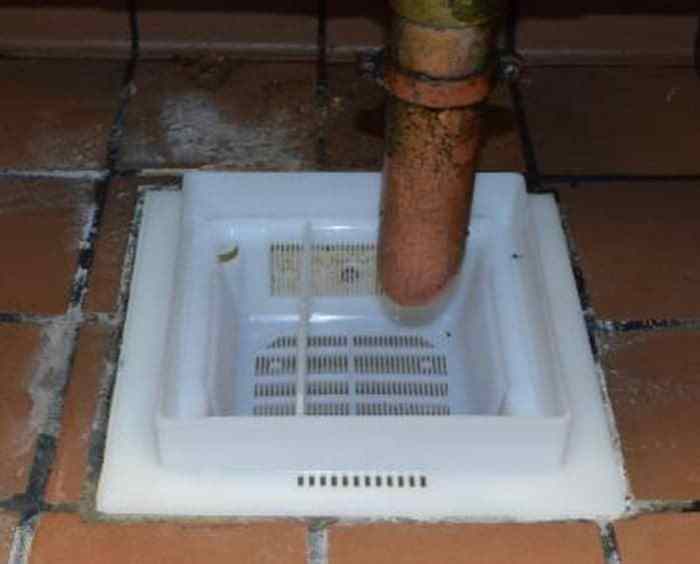
When it comes to choosing between hub drains and floor drains, it’s important to consider their advantages and disadvantages to determine which one is best suited for your needs. Here’s a comprehensive overview of the pros and cons of each type of drain:
Hub Drains
Pros:
- Less visible:Hub drains are typically installed in the center of the shower or bathroom floor, making them less noticeable than floor drains.
- Easier to clean:Hub drains are usually equipped with removable strainers that can be easily lifted out for cleaning, making maintenance a breeze.
Cons:
- Prone to clogging:Hub drains can be more prone to clogging due to hair and soap scum buildup, especially if the strainer is not cleaned regularly.
- May not handle large volumes of water:Hub drains are typically smaller than floor drains, so they may not be suitable for areas that experience heavy water flow, such as large showers or commercial bathrooms.
Floor Drains
Pros:
- Efficient drainage:Floor drains are larger and have a higher flow rate than hub drains, making them more effective at draining water away quickly.
- Less likely to clog:Floor drains have wider openings and are less prone to clogging, as debris can easily flow through them.
- Ideal for large showers and wet areas:Floor drains are well-suited for areas that experience a lot of water flow, such as large showers, mudrooms, or commercial kitchens.
Cons:
- More visible:Floor drains are typically installed along the edge of the shower or bathroom floor, making them more visible than hub drains.
- May require more maintenance:Floor drains do not have removable strainers, so they may require more frequent cleaning to prevent clogs.
Situations Where Each Type of Drain is Best Suited
The choice between a hub drain and a floor drain depends on the specific needs and preferences of the homeowner or business owner. Hub drains are a good option for smaller showers or bathrooms where aesthetics are a priority. Floor drains are more suitable for areas that experience heavy water flow, such as large showers, mudrooms, or commercial kitchens.
Installation and Maintenance of Hub Drains and Floor Drains
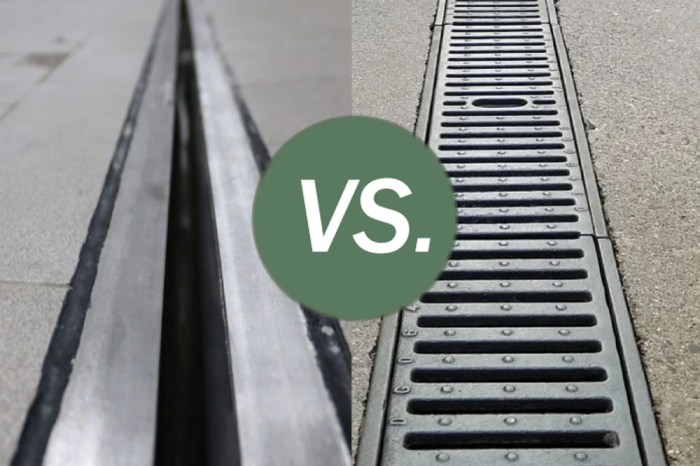
Installing and maintaining hub drains and floor drains is crucial for ensuring proper drainage and preventing water damage. Here’s a step-by-step guide to installing and maintaining these drains:
Step-by-Step Guide to Installing a Hub Drain
- Determine the location of the drain and mark it on the floor.
- Cut a hole in the floor using a hole saw or chisel.
- Insert the hub drain into the hole and secure it with screws.
- Connect the drainpipe to the hub drain.
- Test the drain by pouring water into it.
Step-by-Step Guide to Installing a Floor Drain
- Determine the location of the drain and mark it on the floor.
- Cut a hole in the floor using a hole saw or chisel.
- Install a drain pan under the hole.
- Insert the floor drain into the hole and secure it with screws.
- Connect the drainpipe to the floor drain.
- Test the drain by pouring water into it.
Tips for Maintaining Hub Drains and Floor Drains, Hub drain vs floor drain
- Clean the drains regularly to prevent clogs.
- Inspect the drains for cracks or leaks.
- Replace the drain covers if they become damaged.
- Use a drain cleaner to remove clogs.
- Call a plumber if you have any problems with your drains.
Troubleshooting Hub Drains and Floor Drains
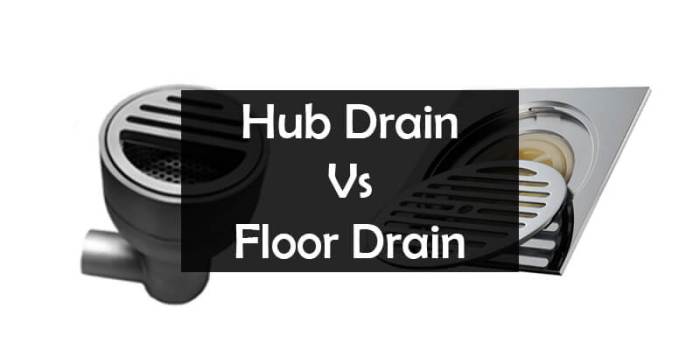
Hub drains and floor drains are essential components of any plumbing system, but they can also be prone to problems. Here are some common issues and their solutions:
Hub Drain Problems
- Clogged Drain:A clogged hub drain can be caused by hair, soap scum, or other debris. To unclog the drain, use a drain snake or a chemical drain cleaner.
- Leaking Drain:A leaking hub drain can be caused by a cracked or damaged drain pipe. To fix the leak, you will need to replace the damaged pipe.
- Slow Drain:A slow hub drain can be caused by a buildup of mineral deposits or a partially clogged drain. To clean the drain, use a vinegar and baking soda solution or a commercial drain cleaner.
Floor Drain Problems
- Clogged Drain:A clogged floor drain can be caused by hair, soap scum, or other debris. To unclog the drain, use a drain snake or a chemical drain cleaner.
- Leaking Drain:A leaking floor drain can be caused by a cracked or damaged drain pipe or a loose drain cover. To fix the leak, you will need to replace the damaged pipe or tighten the drain cover.
- Slow Drain:A slow floor drain can be caused by a buildup of mineral deposits or a partially clogged drain. To clean the drain, use a vinegar and baking soda solution or a commercial drain cleaner.
Preventing Problems with Hub Drains and Floor Drains
Here are some tips for preventing problems with hub drains and floor drains:
- Regular Cleaning:Regularly clean your hub drains and floor drains to prevent clogs and buildup.
- Use Drain Covers:Use drain covers to prevent hair and other debris from entering the drains.
- Avoid Pouring Grease Down the Drain:Grease can clog drains and cause leaks.
- Inspect Drains Regularly:Inspect your hub drains and floor drains regularly for any signs of damage or leaks.
Comparison of Hub Drains and Floor Drains: Hub Drain Vs Floor Drain
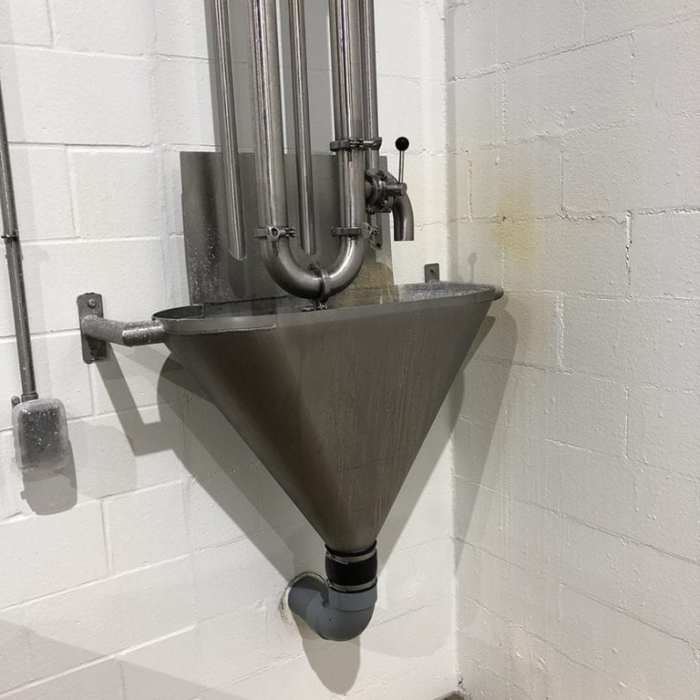
Hub drains and floor drains serve different purposes in plumbing systems. While both are used to drain water, they have distinct features and applications. This table provides a comprehensive comparison of their characteristics:
| Feature | Hub Drain | Floor Drain |
|---|---|---|
| Type | Connects to a pipe or fixture | Installed directly on the floor |
| Purpose | Drains water from sinks, tubs, and other fixtures | Drains water from floors, showers, and other wet areas |
| Materials | Typically made of metal or plastic | Typically made of metal, plastic, or cast iron |
| Installation | Requires a connection to a pipe or fixture | Requires a hole in the floor and a drain body |
| Maintenance | May require periodic cleaning or replacement | May require periodic cleaning or replacement |
| Troubleshooting | Check for clogs or leaks in the connected pipe or fixture | Check for clogs or leaks in the drain body or surrounding area |
FAQ Resource
What are the primary differences between hub drains and floor drains?
Hub drains are typically installed in sinks and bathtubs, while floor drains are installed directly into the floor.
Which type of drain is better suited for high-traffic areas?
Floor drains are more suitable for high-traffic areas as they can handle larger volumes of water.
How often should hub drains and floor drains be cleaned?
Regular cleaning every few months is recommended to prevent clogs and ensure optimal performance.
